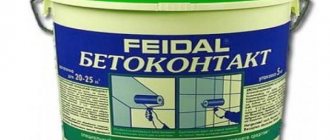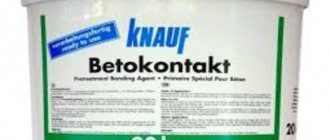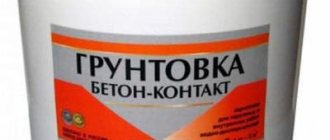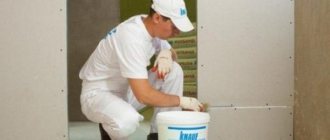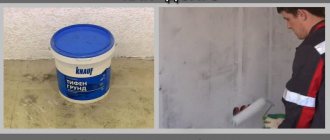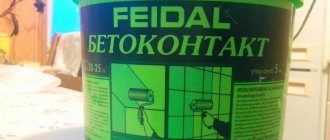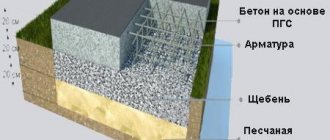Reliable manufacturers of concrete contacts
There are companies on the building materials market that have long established themselves. The primers from these manufacturers differ in composition, purpose and price. The cost is quite affordable: for 5 kg you will have to pay only 300-600 rubles.
Axton
This company produces a wide range of mixtures. The first representative is a high quality dry primer. It is used to treat any surfaces. Before use, add the required amount of water to the concrete contact and stir. The advantage of this material is its high drying speed: at room temperature, the composition sets in 2 hours. A small consumption is declared (300 g per 1 m2), but in reality it turns out to be more.
Ceresit
This water-dispersion primer differs from others in that it is best to apply it with a brush; using a roller is not recommended. It covers smooth surfaces; this concrete contact contains fine-grained quartz sand. The primer must not be diluted with water: high humidity and liquid that gets on the treated base will lead to a loss of properties of the material. It is used only for indoor work.
Knauf
The most famous brand in the domestic construction market. The main components of this material also include fine sand fractions. It is generally accepted that this primer has the best characteristics among other competitors. They make it possible to obtain ideal adhesion to glossy surfaces, such as glass. The first layer under normal conditions dries in an hour; final hardening takes approximately 4 hours. Consumption - about 350 g per 1 m2.
Prospectors
This primer is a domestic manufacturer, but the place of “birth” does not detract from its advantages. The primer mixture is made on the basis of latex. Concrete contact is used for surfaces that do not absorb moisture well - concrete tiles. Due to its low price and low consumption (200 g/m2), the composition is often used when installing self-leveling floors. The product does not require thorough stirring: the contents of the jar are simply shaken.
Optimist
Almost the only company that produces not only a decent primer for treating indoor surfaces, but also high-quality concrete contact intended for outdoor use. These compositions are ideal for preparing bases before applying gypsum, polymer material, and before facing with cement slabs. The minimum drying time for the primer is 3 hours, the maximum is 4. Material consumption is 300 g/m2.
Information about concrete contact: consumption, features of surface preparation and its application - the topic is necessary, but not complicated. Those who have become closely acquainted with the universal material have already become convinced of this. For example, the master from this video:
Primer Knauf Betokontakt
The building materials market is expanding, new products are appearing - some good and some not so good - and there are real bestsellers. One of these useful developments was the Betonokontakt primer manufactured by Knauf. The purpose of this composition is to separate layers of different properties, but at the same time ensure their strong adhesion to each other. Thanks to the new formula, it is now possible to use cladding on complex substrates, saving time and effort on their preparation.
Knauf brand Betonokontakt primer is an adhesive dispersed mixture on an acrylic basis. It is intended for application to low-absorbent, high-density surfaces such as a concrete monolith, on which there is simply nothing for the adhesive or leveling solution to cling to. The primer itself easily sticks to such a base, turning into a solid dark pink film. And adhesion to the subsequent layer is ensured by fine-grained alkali-resistant sand in its composition, which gives the coating the required roughness.
In addition, Betonokontakt Knauf allows you to apply lime and gypsum plaster on cement, although previously this was simply impossible due to the chemical reactions that occur between two dissimilar materials. However, experts found many other types of work where the new primer came in handy:
- Strengthening low-density products (expanded polystyrene, plasterboard sheets) before plastering.
- Laying ceramic tiles directly on old ones without prior dismantling.
- Application to surfaces coated with oil or alkyd enamels for subsequent finishing.
- Reliable fastening of decorative stucco molding to any smooth surfaces after they have been processed by Betonokontakt Knauf.
- Preparation of metal structures, as well as reinforced concrete products with exposed embedded elements for subsequent puttying.
- Strengthening dusty old concrete before finishing work.
The Betonokontakt primer, the main task of which was only to ensure reliable adhesion of the plaster to smooth surfaces, turned out to be very functional. Thanks to it, many repair work has been simplified, especially those related to the preparation of foundations and the dismantling of old resistant coatings. Where previously it was necessary to use several special compounds for various purposes or fiberglass mesh, now one almost universal Knauf primer is sufficient.
Description of the product
The primer involves treating the top layer of walls (ceiling/floor) in order to increase the adhesion of materials. With the help of a primer, they create an even layer on which paint, glue, etc. lie evenly. At the same time, the consumption of the same paint will decrease, that is, the primer saves building materials and improves the final result.
Thanks to the penetration of the product deep into the pores, a protective, durable layer is created that prevents the formation of corrosion, mold and mildew. By tightly hiding small cracks and defects, Knauf primer mixture promotes a smoother finish. But despite the density of the primer layer, the surface “breathes”.
Properties of Tiefengrund
This mixture does not have a specific odor - a clear advantage for the application procedure. It does not emit harmful substances into the air, which makes it harmless to the human body. Tiefengrund mixture is used for a wide range of surfaces: plaster, brick, concrete, etc.
Surface preparation before application
Application of Knauf Betokontakt primer does not require professional training, which allows it to be used at home. Surface treatment is allowed in two ways: classical, carried out using brushes, rollers or a spatula, and mechanized.
First you need to thoroughly clean the base from dust, dirt, and foreign small particles. At the same time, it is not necessary to remove the old coating if it is well preserved and does not crack or crumble. Then the surface is degreased and inspected. Deep cracks and gaps are pre-cemented and left for 24 hours until completely dry. After this, the surfaces are primed. It is worth noting that the soil penetrates several centimeters into the layers of the concrete base, strengthening it.
Buyers speak positively about the Knauf Betokontakt soil mixture, highly appreciating its quality, convenience and ease of application, economy and quick drying.
Knauf is a time-tested brand. This modern primer composition for construction work is popular among many specialists. Knauf Betokontakt guarantees quality and durability, it saves you money and time.
The following video describes the types of primers and the intricacies of priming various surfaces in more detail.
Concrete contact primer: features and consumption per 1m2
A primer is a unique solution that is used to prepare a specific surface for finishing, such as painting. The use of such a building mixture allows you to level the surface, get rid of any defects on the wall and eliminate small cracks.
One of the most popular types of primer is concrete contact, the use of which greatly simplifies further finishing work.
Main characteristics and properties
Concrete contact is a building mixture based on acrylic, which also includes cement, sand and special additives. This mixture is actively used to increase the adhesion of surfaces that do not absorb moisture well, before plastering, laying tiles and carrying out other finishing work.
Among its main advantages are the following:
- high drying speed. Further finishing work can begin a few hours after applying the primer;
- resistance to moisture. During the drying process, a special film is formed that does not allow water to pass through;
- durability. According to the manufacturing company, the concrete contact primer does not lose its qualities for 80 years.
Thanks to its unsurpassed properties, concrete contact has established itself as a unique material that is durable, does not require a lot of drying time and does not allow moisture to pass through. It is these properties that allow you not to worry about the quality of the repairs done.
How to determine the consumption of concrete contact?
The consumption of concrete contact per 1 m2 depends on many factors, among which the first place is occupied by the characteristics of the treated surface
It is not the type of surface itself that is important, but the porosity. It determines how much primer will be absorbed, which has a direct impact on its consumption per m2
Consumption table for concrete contact primer from different manufacturers
Depending on the porosity, the following types of surfaces are distinguished:
- Porous surfaces, which include brick or sand concrete. The primer is absorbed quite intensively, which leads to consumption of concrete contact up to 0.5 kg per m2. If the porosity is too large, then you will first need to treat the surface using special solutions.
- Surfaces with medium porosity. These include concrete and concrete tiles. Concrete contact consumption is about 0.3 kg per m2.
- Low-porous surfaces for which primer consumption is minimal - 0.1-0.2 kg per m2.
Is it possible to reduce primer consumption?
Most people wonder whether it is possible to reduce the consumption of concrete contact primer. The answer is definitely no. First of all, this building mixture has an affordable price, so there is no point in saving on it. In addition, this can cause the material to decrease in strength, which will begin to crack or peel over time.
It should be remembered that the quality of the primer and the work done to apply it has a direct impact on future finishing work and the quality of the entire repair as a whole. If you reduce the amount of concrete contact primer per m2, the surface will lose its ability to adhere. This may cause the coating to separate from the substrate in the future.
Reducing primer consumption may result in loss of surface adhesion
The primer plays an important role in the process of ensuring waterproofing of the surface, which can be compromised when the amount of solution per m2 is reduced
We should also not forget about an important feature of some finishing materials, which is that some coatings can dry out. The fact is that they contain gypsum or Portland cement, and drying out becomes a natural reaction to a decrease in the amount of water
Thus, the use of concrete contact is important for the future of all repairs
All the nuances of using this building mixture should be taken into account. The consumption level of concrete contact per m2 depends on the type of base and its porosity
You should not save when using a primer, as this can negate all further finishing work.
This is interesting: Do-it-yourself renovation of a small kitchen in Khrushchev
Consumption of concrete contact primer
Concrete contact consists of a building mixture (cement, sand, as well as special additives) and acrylic. It is often used to better bond the base, which almost does not absorb moisture before plastering, as well as before laying tiles or other finishing work.
This mixture has a number of advantages:
- dries quickly, which allows finishing within a couple of hours after applying the mixture;
- does not allow water to pass through due to the film created during drying;
- can last up to 80 years.
The quality of the repair will be good thanks to the use of such a primer.
The consumption of concrete contact per 1 m² depends on the characteristics of the base that needs to be processed. Basically, a lot of primer is needed on a porous surface, of which there are 3 types:
- Absorption into brick or sand concrete occurs quickly, which allows the consumption of concrete contact per 1 m² to be up to 500 g.
- Average porosity of concrete or tiles. The consumption for them is approximately 300 g per m².
- 100 – 200 g per m² of primer is necessary for low-porosity surfaces.
Before using this mixture, it is necessary to determine the type of surface, as well as how much primer will be needed.
This video explains the benefits of concrete contact:
Consumption of concrete contact: how much per 1 m2?
For most people, the word “repair” is unlikely to evoke at least some positive emotions. Usually this process is associated with huge expenses: effort, money and time.
One of those tasks that sometimes causes agony even for people with repair experience, even if not professionals, is the need to increase the adhesion of certain materials. This is where the concrete contact primer comes in handy.
Concrete contact is a special type of primer that can transform absolutely any surface from perfectly smooth to as rough as necessary.
It consists of very strong glue, as well as acrylic and quartz sand. Concrete contact is used for external and internal work. The main manufacturers of this material include Knauf, Prospectors, and Master.
Advantages:
- The main positive side of using this primer is that before applying it, you do not have to remove old coatings from the place where you want to apply it.
- You don’t have to use reinforcing mesh during plastering work, and using concrete contact on the plaster will increase its strength, since the solution penetrates into the plaster coating and holds it together. This means that after using concrete contact you will be able, for example, to drill or perform other similar work without fear of significant damage to the finish.
- When working with this substance, you do not need to use special protective equipment, because it is an environmentally friendly substance that does not contain any solvents or other harmful substances that can harm your health.
- Walls treated with concrete contact will not stop “breathing”, and mold and other types of fungi will never appear on them.
Perhaps you will find useful information on how to prime walls for wallpaper. Read this article.
Flaws:
- You cannot store this material in the cold because it will lose its properties.
- If applied incorrectly, it will not perform its basic properties.
to contents
Consumption rates
Despite the fact that the name of this material contains the word “concrete,” concrete contact can be used on completely different surfaces.
Accordingly, the rate of its consumption will be completely different. It depends, first of all, on the porosity of the surface on which you apply it.
And although the simplest and most reliable way to determine the rate of consumption of concrete contact is to simply apply it to a part of the desired surface with an area of \u200b\u200bone square meter, let's still consider the approximate rate of consumption of this material.
- On highly porous surfaces, such as concrete slabs, bricks or special porous stones, you should apply 0.5 kg per 1 m2.
- For materials with medium density, such as concrete monolith or concrete tiles, you will need 0.3 kg per 1 m2.
- Low-porous surfaces (ceramics, tiles) will require at least 0.15 kg of concrete contact per 1 m2.
to contents
DIY primer application
First you need to clean the surface of debris and dirt, dust and everything else. Next you will need a roller or brush.
It is necessary to carefully place the concrete contact in the container and use a roller to apply it in an even thin layer on the wall. Corners and hard-to-reach places are treated with primer using a brush.
When performing work, you need to monitor the temperature in the room. It should not be below +5 °C.
Now the main job is done and you can rest a little. You must wait until the concrete contact is completely dry
This is very important because if it is even a little wet, it will significantly reduce the quality of adhesion
Complete drying of the concrete contact usually occurs after 5-6 hours. After this time, you can begin further finishing.
You cannot delay the continuation of finishing work, because after more than two days the surface will dry out and become dirty.
Now that you have learned about this wonderful type of primer, your renovation will be easy and enjoyable.
Video review of concrete contact primer.
The principle of applying concrete contact
Bolars concrete contact primer
In terms of quality characteristics, the primer does not always comply with GOST, and in general, it is not a product subject to mandatory certification. Many manufacturers rely on this, producing their products without proper control of production, technology and raw materials. To completely dispel all doubts about which concrete contact is better, watch the video in this article.
So, let’s clarify again: concrete contact primer, consumption per 1 m2 is on average 300 g/m2. Based on this, we try to adjust the specified standards to the actual thickness of the application.
General recommendations for all types of such compositions will tell you how to do this:
- Before using concrete contact, some surfaces are sometimes primed with a traditional compound to remove dust clots and increase adhesion.
- Concrete contact is applied to a dry surface using conventional painting tools: a roller or a brush. A brush with wide bristles is more productive in work.
- Before continuing finishing, you must make sure that the concrete contact layer is completely dry. Otherwise the work will be ruined.
Particular attention should be paid to the manufacturer's instructions, which indicate not only the primer consumption per 1 m2, but also the subtleties of working with it. But this is not the only thing you need to know when preparing to work with such adhesive material
There are also a lot of certain subtleties:
- Some formulations are ready for use immediately after opening the can, while others must be diluted with water. It would be a good idea to get information about the recommended surfaces that can be primed and which ones should be avoided.
- All this depends on the chemical composition of the substance and affects its performance characteristics. If a mixture intended for interior work is used to cover the facade of a building, this can lead to disastrous consequences after the last layer of finishing material has been fixed. And then the concrete contact primer will have a colossal consumption.
- Some people use special technical means to apply such substances. The packaging will necessarily indicate if this is possible and acceptable in relation to a specific mixture.
- Drying time may not be as stated in conditions of high humidity in the room. As soon as this happens, it is necessary to continue work immediately so that dust and dirt do not accumulate on the treated surface, which will harm the adhesive properties.
- The best concrete contacts are acrylic. They do not interfere with the penetration of air and do not disturb the microclimate of the room, no matter from which side they are applied.
- Concrete contacts can be safely stored in closed containers for a year. You just have to comply with one condition: the ambient temperature should not fall below zero degrees. If the mixture freezes, it will lose all its properties, but it is resistant to mold, fungi and parasites.
- An open jar/bucket or diluted mixture cannot be stored for a long time. Solutions dry out quickly. Especially those that are water based.
Betonokontakt acrylic primer “Luxorit”
Concrete contact is an inexpensive material. Therefore, when using it, you should not strive to reduce consumption, to the detriment of the quality of work. The lack of a concrete contact layer will bring more significant material losses than buying another package.
Area of use
Primers are used to improve adhesion properties, as well as to improve the strength of the base, which is processed using the material. For each type of soil there is an instruction that specifies the composition, material consumption per m2, as well as for what work, external or internal, it can be used.
Concrete contact primer is used for the following purposes:
- The properties of the primer make it possible to use it before screeding or self-leveling floors, which is why it is often called a primer for concrete floors
- Primer for concrete is used to treat surfaces before finishing with plaster or putty.
- To reduce the porosity of plasterboard slabs before gluing trellises or laying tiles
- The composition allows you to use betokontakt before whitewashing the ceiling
The technical characteristics of the concrete primer can be used for work with non-absorbent surfaces. These can be bases coated with varnish or paint, or tiled. The most important thing is that for this there is no need to dismantle the old coating, because a penetrating primer is applied over these materials, forming a rough surface that adheres well to the new finishing elements. It is worth clarifying that the concrete contact primer has an environmentally friendly composition, and this allows it to be used in any room. Although GOST specifies what composition the primer should have, many manufacturers may deviate slightly from the list of elements, although this does not in any way affect the quality of the material.
Let's look at the technical characteristics and properties of the primer:
| Drying process | Very fast compared to other types. On average, after 2.5 hours you can continue finishing work |
| Moisture resistance | After drying, the soil forms a film that repels water and thereby protects the base from premature destruction |
| Life time | Many manufacturers indicate a service life of 80 years. However, for this, the instructions for applying primer must be followed. |
| Application method | It is possible to use both manual and mechanical options |
| Composition distribution | Pigments that may be included in the primer help ensure uniform application |
Betonokontakt Knauf
Also, the sweep consumption depends on the manufacturer. Different manufacturers have their own composition and proportions, which changes the amount of material consumed. For example, you can consider the consumption of Knauf Betokontakt primer per 1 m², its properties and consumption.
This mixture is used for foundations that do not absorb moisture or do so poorly. In this way, the material for plaster or putty is prepared. You can also consider the technical characteristics of the Knauf Betokontakt primer, which also includes the composition consumption:
- dries in less than a day;
- good concentration;
- applied by roller or mechanically;
- mixture consumption is 250-350 g per 1 m², taking into account that the material was not previously diluted.
The composition can be used for concrete, monolith, reinforced concrete, plasterboard or expanded polystyrene. It is also suitable for application to plaster or before gypsum-lime plaster is used.
Bucket of Knauf mixtureSource materik-m.ru
Consumption of concrete contact: how much per 1 m2?
For most people, the word “repair” is unlikely to evoke at least some positive emotions. Usually this process is associated with huge expenses: effort, money and time.
One of those tasks that sometimes causes agony even for people with repair experience, even if not professionals, is the need to increase the adhesion of certain materials. This is where the concrete contact primer comes in handy.
What is concrete contact?
If you are not an experienced builder, then this is probably the first time you have heard this word, so we should figure out what this substance is.
Concrete contact is a special type of primer that can transform absolutely any surface from perfectly smooth to as rough as necessary.
It consists of very strong glue, as well as acrylic and quartz sand. Concrete contact is used for external and internal work. The main manufacturers of this material include Knauf, Prospectors, and Master.
Advantages and disadvantages
This type of primer, like any material, has its pros and cons. Let's look at them in more detail.
- The main positive side of using this primer is that before applying it, you do not have to remove old coatings from the place where you want to apply it.
- You don’t have to use reinforcing mesh during plastering work, and using concrete contact on the plaster will increase its strength, since the solution penetrates into the plaster coating and holds it together. This means that after using concrete contact you will be able, for example, to drill or perform other similar work without fear of significant damage to the finish.
- When working with this substance, you do not need to use special protective equipment, because it is an environmentally friendly substance that does not contain any solvents or other harmful substances that can harm your health.
- Walls treated with concrete contact will not stop “breathing”, and mold and other types of fungi will never appear on them.
Perhaps you will find useful information on how to prime walls for wallpaper. Read this article.
- You cannot store this material in the cold because it will lose its properties.
- If applied incorrectly, it will not perform its basic properties.
Consumption rates
Despite the fact that the name of this material contains the word “concrete,” concrete contact can be used on completely different surfaces.
Accordingly, the rate of its consumption will be completely different. It depends, first of all, on the porosity of the surface on which you apply it.
And although the simplest and most reliable way to determine the rate of consumption of concrete contact is to simply apply it to a part of the desired surface with an area of \u200b\u200bone square meter, let's still consider the approximate rate of consumption of this material.
- On highly porous surfaces, such as concrete slabs, bricks or special porous stones, you should apply 0.5 kg per 1 m2.
- For materials with medium density, such as concrete monolith or concrete tiles, you will need 0.3 kg per 1 m2.
- Low-porous surfaces (ceramics, tiles) will require at least 0.15 kg of concrete contact per 1 m2.
DIY primer application
First you need to clean the surface of debris and dirt, dust and everything else. Next you will need a roller or brush.
It is necessary to carefully place the concrete contact in the container and use a roller to apply it in an even thin layer on the wall. Corners and hard-to-reach places are treated with primer using a brush.
When performing work, you need to monitor the temperature in the room. It should not be below +5 °C.
Now the main job is done and you can rest a little. You must wait until the concrete contact is completely dry
Complete drying of the concrete contact usually occurs after 5-6 hours. After this time, you can begin further finishing.
You cannot delay the continuation of finishing work, because after more than two days the surface will dry out and become dirty.
Now that you have learned about this wonderful type of primer, your renovation will be easy and enjoyable.
Video review of concrete contact primer.
Consumption proportions of the main types of primer
There are no standard proportions for soil consumption per 1 m2 as such. There are several factors that invariably affect flow parameters:
- structure and type of surface being processed (wood, metal, concrete, granite, etc.);
- ambient temperature and air humidity level;
- chemical composition of the primer.
Below we will look at a calculation that we hope will help you determine the approximate primer consumption per 1 m2:
| Type of primer | Approximate norm | additional characteristics |
| Concrete contact | 350 g/m2 | It has a high level of adhesion (cohesion), designed for processing dense surfaces with low absorbent (absorbing) properties. Used before covering the work surface with tiles or plaster. |
| Alkyd primer | 120 g/m2 | For processing plasterboard, as well as wooden surfaces, chipboard (chipboard), fiberboard (fibreboard). |
| Water-dispersed | 100 g/m2 | Used to prepare the working surface for painting. |
| For decorative plaster | 200 g/m2 | During finishing work before plastering. |
| Specialist. primer before wallpapering | 120 g/m2 | No |
| Universal for metal and wood processing | 120 g/m2 | Used to prepare the surface for enameling. |
| Universal type "Optimist" | 130-250 ml/m2 | This is a mixture of several types of specialized primers. Well suited for both metal surfaces and wooden or concrete-stone surfaces. In the instructions for use, as a rule, the proportions for each type of base being processed are written. |
| Anti-corrosion / Primer VL-02 | 10 g/m2 / 120 g/m2 | Necessary before painting surfaces made of ferrous metals (iron, cast iron, steel). |
The above standards are not clear standards, but rather indicative. In most cases, true consumption depends on the level of damage to the material being processed. For example, several layers of primer are applied when the surrounding climatic environment quickly affects the deformation and deterioration of the surface being treated.
Positive properties and characteristics of concrete contact
The composition can be used in diluted or undiluted form on any building surface, if it is clean: it can be old concrete cladding, plasterboard, any paint and varnish compositions, tile cladding. If it is necessary to dilute the primer, it is better to do it with clean water.
The grain size in the liquid is 0.3 and 0.6 mm. I use the first composition before puttying, the second option - before plastering surfaces. Given that the liquid does not allow moisture to pass through, it is recommended to apply it as quickly as possible so that the surface to be painted does not have time to be moistened by natural moisture from the atmosphere. This is also required so that the surface under the primer does not become infected with fungal infections. To do this, antibacterial and antifungal substances are additionally introduced into the primer.
Features of working with universal material:
- To prevent the concrete contact from starting to fall off over time, swelling on old surfaces must first be eliminated;
- To get high-quality and long-term results, dilute the primer according to the instructions;
- Follow the application technology so that the walls are well saturated with the substance.
Consumption
It is all these signs that determine how much primer you spend per square meter of surface. This indicator is most often indicated on the packaging, because this is the most important characteristic that allows you to know how much material it costs to purchase, so as not to run around for additional materials.
The consumption of deep penetration primer depends on the following factors:
- the amount of primer used is affected by the material of the surface on which the material will be applied (metal, wood, stone);
- the composition of the primer itself, namely its elements, their proportion, which is directly specified by the manufacturer;
- the amount of material used is also affected by the type of further dye, glue and building material;
- Another important factor is the time of year and weather conditions.
All these factors in one way or another affect the future consumption of material. But there is still one parameter that affects the consumption rate - this is the method of applying the material, as well as the tools themselves that are used during work.
The tools you use to apply the primer have a direct bearing on how much primer you will use on the selected area. The substance itself is sold in containers of different sizes, you select the one you need.
The primer can be applied to a vertical surface using special tools. A roller is a fairly convenient way to apply material to vertical walls.
Roller
The most common option for painting hard-to-reach areas is a brush. The brush is used when applying material to seams, when processing corners and hard-to-reach places;
Brush
Sprayers are also used when applying primer.
Spray
The primer is available in a liquid version and has a transparent composition and can be used before gluing wallpaper; if you are processing wood, you should choose a moisture-proof material.
It contains pigments of a darkish color, which allows you to clearly see the boundaries of application when applying it, but you should understand that when using this type of primer, you should remember one rule: in no case should the primer be darker than the topcoat.
If it is metal, then 80-100 g per square meter is enough. You should know that when working on metal, it is necessary to use a primer without acrylic, this is due to the fact that rust does not appear on such a primer. But before applying primer to metal, it must be carefully prepared for use.
If before applying the primer the metal surface was used quite often, then there is clearly fluffy rust left on it, then you can easily get rid of it using the right tools (brush).
This is necessary so that the old metal does not absorb the primer, which means that if you do not treat the material in advance, you can spend twice as much paint and varnish materials during further processing. In order to treat a metal surface with a primer, you should choose one based on resins.
It can be used on both metal and concrete. 80-100 g per square meter is considered the most minimal indicator among all available bases. The consumption rate for deep penetration primer per 1 m2 based on acrylic is 120-150 g per square meter.
Acrylic primer easily and simply dissolves in water; you can buy it in the store in powder form or in the form of a concentrated liquid.
In its structure, such a mixture will resemble a simple whitewash, therefore, there is no point in using it on dark surfaces. This primer is good for painting with acrylic paints. Can be used both inside the house and outside.
The use of a primer before applying the base material to the surface is not the case. If you neglect this advice, then you can consider that the money spent on finishing materials is thrown away.
There are certain calculation rules based on which you can determine how much primer you will need to treat a particular room. The first thing to do is calculate the total area of the room, but at the same time take into account its properties.
It is worth understanding that walls, floors and even ceilings have different density characteristics, therefore, it is worth calculating for each surface separately. The primer packaging indicates several indicators of material consumption.
Approximate material consumption values:
the primer based on acrylic can be consumed with an approximate value of 110-160 g / square meter;
Acrylic
the Knauf company's primer, which is used for walls, can be consumed from approximately 50 to 130 g/square meter;
Knauf
The approximate consumption of deep penetration primer (in general) is 100 g per square meter.
Briefly about the main thing
The primer is necessary so that after applying it, glue, paint or other wet compounds can be used without effort on the base.
Primer consumption depends on the condition of the base. You can also calculate it if you apply the composition to a piece of wall approximately 1 by 1 m, and then calculate how much mixture was used.
Concrete contact mixture is considered the most durable among the others. Of these, Knauf is considered the highest quality, which lasts up to 80 years and holds the base well with other materials.
How and with what is drywall primed for different finishes?
There are several other points that may affect the choice of soil. First you need to decide on the properties of the material. They are as follows: The primer must be applied twice at intervals so that the first layer dries out. Usually wait from 12 to 24 hours. Although many manufacturers claim that 6 hours should be enough.
But it’s better not to rush, because humidity and temperature are different everywhere. The weight of ceramic tiles is quite large, so you need to make sure that they are held firmly. Tile adhesive helps with this, but you can’t do without primer. It’s not difficult to guess how to prime drywall before laying tiles.
It is worth choosing the same deep penetration acrylic primer with antifungal properties. When choosing specific products from different manufacturers, you need to make sure that they are suitable for working with ceramic tiles
It is worth paying attention to the primer consumption for drywall per 1m2. This indicator is always indicated by the manufacturer on the packaging
You should always add about 10% to it to get a real result.
It should also be taken into account that the consumption is indicated for one layer, but you will need to apply the primer in two layers (the second is applied after the first has completely dried). Consumption usually ranges from 100-150 grams per square meter. When the question arises of what primer to use on drywall, you need to decide what types of this material exist.
It is important to choose a material based on the manufacturer, but still, you need to know about its existing varieties. The main types are as follows:
Additional information on the topic:
- How to assemble a frame for a niche in a plasterboard wall photo
- How to hide a beam on the ceiling in a wooden house with plasterboard
- How to install a plasterboard arch on a video profile
- Is it necessary to putty drywall before gluing liquid wallpaper?
- How to glue ceramic tiles to drywall other than tile adhesive
Peculiarities
Often the adhesion of two different types of materials during finishing is quite problematic. Thanks to the soil, for example, betokontakt, the adhesion rate increases significantly even when the surface practically does not absorb moisture. The primer consists of cement, sand, and other special additives that create a rough layer formed by the sand, and the cement allows the mixture to adhere well to the walls.
Betokontakt Knauf primer is made only from safe, environmentally friendly components that do not emit unpleasant odors, do not harm human health and do not spoil the appearance of surfaces.
